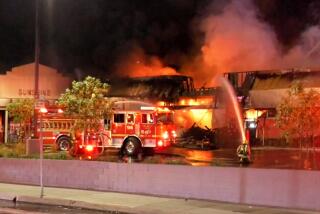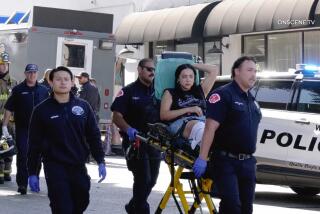Town Proud of Its Historical Roots : Whittier: Started as a Quaker colony, the city offers homes with great range of prices.
- Share via
One of the most pleasant experiences for Bonnie Vick shortly after she and her husband, Jim, moved into their East Whittier home in April, 1990, was watching a young man fly a kite in the schoolyard that adjoins their back yard.
“We had lived in Ontario near a highway, and here it’s so quiet you can hear a kite fly,” she said.
Bonnie Vick had wanted to be nearer her work in Pico Rivera, and they had looked at several locations. “We really liked this area,” she said. “It’s a real pretty town. It’s not just a bedroom community. There are real trees and older homes.
“We’re on a little hill and we can see out into the valley. On the Fourth of July we watched 10 different fireworks displays across the horizon.”
The 37-year-old, 1,600-square-foot home the Vicks purchased is north of Whittier Boulevard. They paid $250,000 for the three-bedroom, two-bath house with pool.
While Jim Vick, a pilot, still has a hefty commute to Los Angeles International Airport, Bonnie described her commute as a “relaxed drive down Whittier Boulevard.”
This is the same route that has been used by travelers since 1771, when the San Gabriel Mission was established and priests, farmers, settlers and soldiers traveled El Camino Real from San Diego to San Francisco. Whittier Boulevard was a section of that famed route.
And it was the rolling hills and the views stretching to the ocean that in 1887 attracted Aquilla H. Pickering from Chicago in his search for a site for a Quaker colony.
He and his wife, Hannah, had traveled for three months on the West Coast from Sacramento to Ensenada when they discovered the 1,259-acre John M. Thomas ranch.
The ranch on the southerly slopes at the western end of the Puente Hills was for sale, and they considered it the ideal location. That May 11, 1887, purchase was made by the newly organized Pickering Land & Water Co. for $69,890. The name Whittier was selected for the new community in honor of John Greenleaf Whittier, the New England Quaker poet.
The establishment of Whittier coincided with the great land boom of 1887-88. The climate and scenery as well as the extension of the Southern Pacific, and the building of the Santa Fe Railroad were bringing tourists from the East who tended to stay and look for land and homesteads.
A problem was the lack of adequate water, and when various efforts were successful in meeting that problem, the town site settled into slow growth, and Whittier was incorporated in 1898.
Today the city of Whittier has a population of 77,671. The incorporated area is bounded by Valley Home Avenue (La Habra) on the east, Lambert Road and Los Angeles County on the south, the cities of Santa Fe Springs and Pico Rivera on the western edge and La Habra Heights and the Puente Hills across the northern area.
Whittier Boulevard cuts through the city and offers a multitude of commercial establishments, including two large and many small shopping centers as well as access to the 605 Freeway at the western border.
Of historical interest along this route is the former home of Hannah Nixon, which is at present an antique shop owned by Luis and Marie Dashwood. They bought the property from Richard M. Nixon in 1975 for $85,000.
The English Tudor-style house of about 1,600 square feet has three bedrooms and one bath and is situated on a large lot. It had been used as a rental for several years following the death of the former President’s mother in 1967. As a youngster, Nixon had lived in this home.
Karen Profeta recalls that her grandfather owned a service station on Whittier Boulevard and sold gasoline to the future President when he was a college student. A fourth generation Whittier resident, Profeta’s family on her grandfather’s side came in 1910. Her grandmother’s side of the family moved to Whittier from El Monte at the turn of the century.
Profeta and her husband, Jeff, have owned two homes. The first was a two-bedroom, one-bath house they purchased in 1973 for $22,000 and sold four years later for $45,000. They bought a replacement home for $60,000. “It was a fixer-upper and if in good condition would have sold for around $70,000,” she said. The three-bedroom, two-bath home has 1,900 square feet and they have added a swimming pool.
This young family has stayed in Whittier because of family tradition and a belief that the Whittier school system is extremely good.
Forrest Dickensin was born in Whittier in 1917 and grew up on the citrus ranch his family operated. They had moved to the city in 1913. Forrest met his wife, Ruth, in Pasadena, and they purchased their Whittier home in 1944 for $5,500. The 1,800-square-foot Spanish stucco has three bedrooms and one bath. When they made the purchase the area was surrounded by citrus groves. Today it is all residential.
Located north of Whittier Boulevard, the neighborhood is within walking distance of shopping, parks and other conveniences and Dickensin says they have never considered selling and moving elsewhere. He said his father sold the 10-acre citrus grove, on Whittier Boulevard west of Colima Boulevard, in the 1960s. Homes in their neighborhood now are selling for around $160,000 and up, he said.
The city’s most expensive homes are in Friendly Hills in northeast Whittier. Older homes on large view lots are offered in the $500,000 range.
Realtor Yvonne Eytchison of Friendly Hlls Realty Inc. said that in newer Friendly Hills Estates, a gated community, prices run well over a million.
“We had one listed at $2.1 million,” Eytchison said. “These homes have lots of marble, large master suites with sitting areas and fireplaces and wet bars. Most of these homes have great views. They will often have maid’s quarters, a library or study.”
There are also plenty of desirable starter homes in nice neighborhoods, Eytchison said. “A real basic three-bedroom, one-bath home would start at $190,000 in the Michigan Park area. That would probably be around 1,000 square feet.”
George Reyes, president of the Whittier District Board of Realtors and owner-broker of West Avenue Properties Inc., said he had just made an offer on a house in the Mar Vista area (west of Colima Boulevard) listed for $325,000. The 30-year-old home is 2,000 square feet with pool and spa in a quiet, secluded area with mature trees.
“In this city you have something for everybody,” he said. In some neighborhoods, usually south of Whittier Boulevard, there are homes for $155,000 to $165,000. “I would say the average sales price is from $180,000 to $200,000,” Reyes said.
Condos in Whittier sell for from $140,000 to $300,000, depending on location, he said.
Eytchison said she finds that people like Whittier because the uptown area is quaint and it is a nice, clean town with tree-lined streets. “ . . . People who move here from the East can relate to this town. Whittier has a lot of character. A lot of history.”
Robert and Becky Blake like Whittier for several reasons; among them the historical aspects. The town still seems to have a Quaker influence, he remarked. “It’s the type of environment that is really enjoyable to live in. Not a rat race. The city has wanted to keep this area as historical as possible, to preserve it. That is the feeling I get in Whittier.”
The Blakes moved to Whittier in 1989 and purchased a 30-year-old home in an older neighborhood for around $400,000. The three-bedroom, two-bath home has 2,000 square feet, a spa, and is on three-fourths of an acre. It had been extensively refurbished.
Robert Blake explained that they own Why Grow Up, a manufacturing company of children’s clothing based in Montebello. He had grown up in that city, and when it came time to move to a new residential area, Whittier became the location of choice.
“We might have chosen Malibu--somewhere by the ocean, and no smog, but that was too far from business,” he said. Whittier was next best. He said that they do have smog, but that it’s not as noticeable as in some of the areas they considered.
He said that they have enjoyed the old downtown section and that they see a lot of progress in the rebuilding of the damage caused by the 1987 earthquake.
The 6.1 quake and 5.5 aftershock caused an estimated $90 million in damage. In all, 5,000 Whittier homes and businesses received substantial damage. In the old Uptown Village, 34 buildings were destroyed and 23 damaged. Many of these old brick structures have been rebuilt, and work progresses on others. Businesses have returned and there have been new entries. While many residents view Whittier for historical values and family tradition, it has contemporary problems.
Chuck Drylie, community relations crime prevention officer with the Whittier Police Department, said the city has its share of low- income housing where the crime rate is a bit higher. It also has a minor gang problem.
“Auto theft is our main priority,” he said. “There is the graffiti that goes along with the gang problem. They get together and claim an area and they mark it up.” Concerning drugs, he said police are trying to stop the trade before it gets into the city in a major way.
AT A GLANCE
Population
1990 estimate: 77,671
1980-90 change: +11.4%
Median age: 32 years
Annual income
Per capita: $ 17,410
Median household: $ 35,681
Household distribution
Less than $20,000: 27.6%
$20,000 - $40,000: 28.2%
$40,000 - $75,000: 30.2%
$75,000 - $150,000: 11.4%
$150,000 +: 2.6%
More to Read
Sign up for The Wild
We’ll help you find the best places to hike, bike and run, as well as the perfect silent spots for meditation and yoga.
You may occasionally receive promotional content from the Los Angeles Times.






